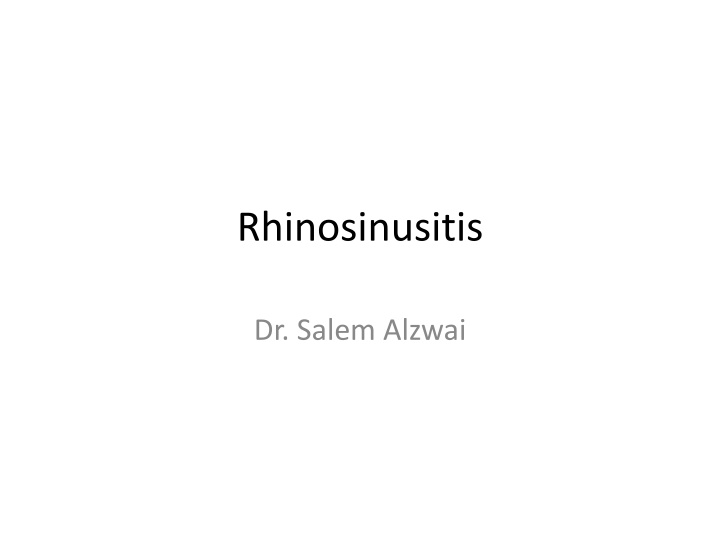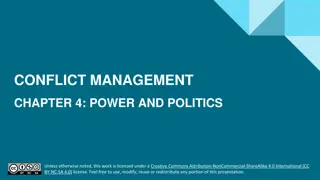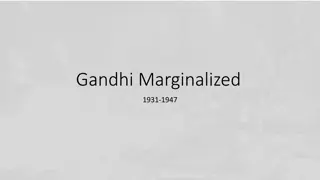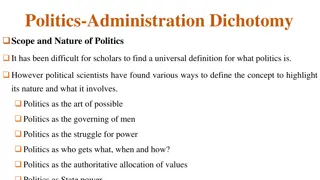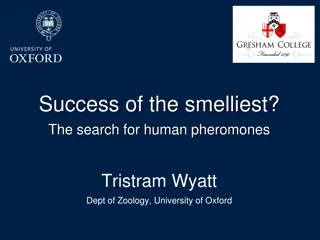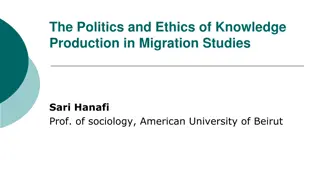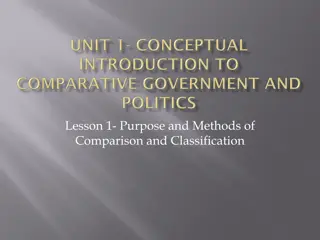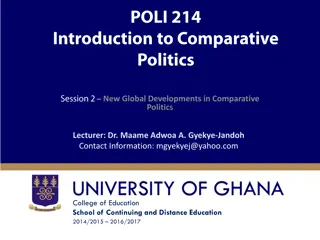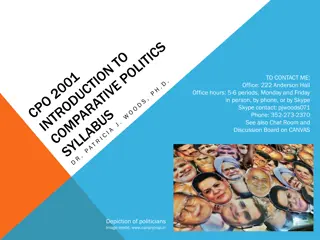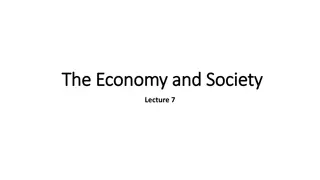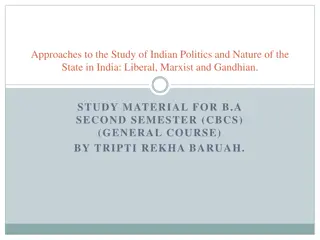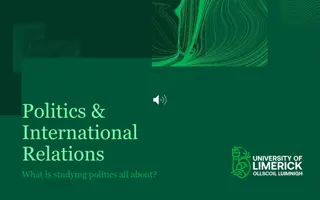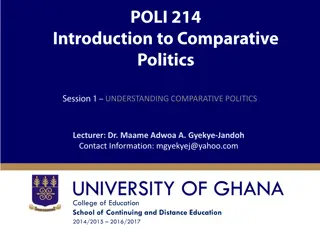Global Politics Unraveling Global Complexities
Global politics is a dynamic field weaving together diverse cultures, histories, and ideologies into a complex framework. It impacts economies, security, and social structures worldwide, creating ripple effects across borders. Understanding this complexity enables effective navigation of political landscapes, fostering better international relationships for thriving in an interconnected world."
Download Presentation

Please find below an Image/Link to download the presentation.
The content on the website is provided AS IS for your information and personal use only. It may not be sold, licensed, or shared on other websites without obtaining consent from the author.If you encounter any issues during the download, it is possible that the publisher has removed the file from their server.
You are allowed to download the files provided on this website for personal or commercial use, subject to the condition that they are used lawfully. All files are the property of their respective owners.
The content on the website is provided AS IS for your information and personal use only. It may not be sold, licensed, or shared on other websites without obtaining consent from the author.
E N D
Presentation Transcript
Rhinosinusitis Dr. Salem Alzwai
Sinusitis is defined as inflammation of paranasal sinuses. Rhinitis is defined as inflammation of within the nasal cavity.
Calssifcation Acute rhinosinusitis. Chronic rhinosinusitis: CRWNP CRSNP
Acute rhinosinusitis is defined by the presence of the condition for up to 4 weeks. Chronic sinusitis can be diagnosed after the condition has been present for at least 3 months. Subacute rhinosinusitis is used when the duration is between 4 and 12 weeks. Recurrent acute rhinosinusitis: four or more episodes of acute rhinosinusitis in one year with resolution of symptoms between the episodes.
Rhinosinusitis is a common disorder and has a huge economic burden
Acute rhinosinusitis Pathophysiology: Infection and inflammation
Acute viral rhinosinusitis The majority of acute rhinosinusitis is caused by viruses. The most commonly isolated virus in community acquired rhinosinusitis is rhinovirus followed by influenza virus, parainfluenza virus and adenovirus.
Acute Bacterial Rhinosinusitis It typically occurs following AVRS. Only about 0.5 to 2.0% of AVRS are complicated by bacterial infection. The most commonly isolated bacterial species are S. pneumoniae, H. influenzae and M. catarrhalis.
Presentation Nasal obstruction, nasal discharge, nasal purulence, postnasal drip, facial pressure and pain, alteration in the sense of smell, cough fever, halitosis, fatigue, dental pain, sore throat, aural fullness, otlagia and headache.
Diagnostic criteria for ABRS Up to 4 weeks of purulent nasal drainage ( anterior, posterior or both) accompanied by nasal obstruction, facial pain-pressure-fulness or both. Symptoms or signs of acute rhinosinusitis are present for 10 day or more or worsen within 10 days after initial improvement ( double worsening ).
Imaging CT scan MRI
Medical management of AVRS Analgesia Decongestants Nasal irrigation
Medical management of ABRS Antibiotics Analgesia Decongestants Topical steroids Nasal irrigations
Chronic rhinosinusitis Complex pathophysiology with contribution of chronic inflammation. CRS subtypes: polypoidal VS nonpoypoidal eosinophilic VS noeosinophhilic allergic fungal VS nonallergic fungal
Risk factors Host factors: Congenital conditions: cystic fibrosis, immotile cilia syndrome. Allergic or immune conditions: environmental allergy, HIV, immune suppressive agents. Vitamin D deficiency Paranasal sinuses anatomic abnormalities: concha bullosa, sever nasal septal deviation. Presence of neoplasm
Microbial factors: bacterial biofilms, super antigens( Staph. Aureus), fungal infection. Environmental factors: smoking and exposure to second hand smoke have been identified as morbid cofactors in CRS.
Diagnostic criteria for CRS 12 weeks or longer of two or more of the following signs and symptoms: Mucopurulent drainage ( ant., post,. Or both ) Nasal obstruction ( congestion ) Facial pain-pressure-fullness Decreased sense of smell AND inflammation documented by one or more of the following findings: Purulent mucous or edema in the middle meatus or ethmoid region. Polyps in the nasal cavity or middle meatus Radiographic imaging showing inflammation of the PNS.
Treatment Antimicrobial therapy Anti-inflammatory therapy. Saline irrigiation Immunomodulating agents: leukoterien receptor antagonist ( montelukast ), 5-lipoxygenase inhibitor ( Zileuton ), surfactants Although medical therapy is always considered in first line, endoscopic sinus surgery is the final treatment pathway for many patients.
Complications of sinisitis Extracranial Intracranial
Extracranial complications Orbital extension (Chandler classification) Preseptal cellulitis Postseptal cellulitis Subperiosteal abscess Orbital abscess Cavernous sinus thrombosis Permanent anosmia Pott Puffy tumor
Management of orbital complications All patients need antibiotics Most cases of preseptal and postseptal cellulitis can be successfully managed medically except: If the condition of the patient fails to improve within 48 hours of proper antibiotic use ( for C&S) If visual acuity worsens Progressive proptosis Opthalmoplegia Development of abscess Surgery includes endoscopic and external approaches.
Intracranial complications Spread of infection from PNS to the brain is through osteomyelitis, thrombophlebitis, septic emboli or a post traumatic, surgical or congenitla defects. Meningitis Extradural abscess Subdural abscess Intracerebral abscess Cavernous and superior sagittal sinus thrombosis.
